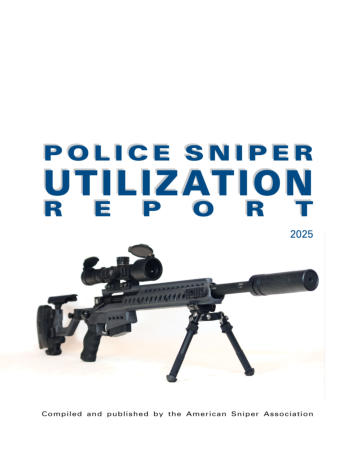

AMERICAN SNIPER ASSOCIATION 863-385-7835 INFO@AMERICANSNIPER.ORG
Copyright American Sniper Association 2022
Sniper Survey
What is the average distance of a police sniper shooting in the United States? When most people in the tactical community are asked this question, the answers tend to be in the range of 70 -77 yards. When asked about the source of their information, almost all allude to "the FBI statistics." Would it come as a shock to you to hear this is a myth? The American Sniper Association tried to obtain a copy of that report to study and evaluate. We checked a variety of resources and followed referrals to people who would have the report. Much to our surprise, we discovered the report does not exist. According to the FBI, they do not, nor have they ever, collected that kind of data. For thirty years, that "70 something" number has been reported as fact. Schools, manuals and articles refer to it to this very day. It has been used as the justification for training, equipping and deploying snipers for decades. The foundation for all of those beliefs and practices does not exist. Knowing the importance of this information, and the training and deployment issues it will raise, ASA decided to embark on a major project. We currently have a team of volunteers contacting every law enforcement agency in America to find out if they have a sniper element. If so, then we have a series of questions about any shootings in which their team may have been involved. From the questions asked in the survey, we are learning from what distances shots are being taken. We are learning about times, conditions, weapons, scopes and ammunition used, shot placement, results and bullet performance. We are also collecting anecdotal information from individual sniper incidents, each of which has important lessons learned. And for the first time in history, all of this information will exist in one formal report. This is a monumental accomplishment. The finished report is not a dry recitation of statistics. It contains facts and numbers, but also includes lessons learned and details of significant incidents. • In addition to being able to finally establish the real "average distance" of a police sniper engagement, we also point out the special circumstances, with important learning points. • Readers will learn the times of day and night shootings have occurred. This will emphasize the importance of varying training hours. • The report presents evidence to support the need to practice shooting positions beyond prone bipod. Snipers have had to employ a variety of improvised positions to accomplish their missions. • Anecdotal evidence is presented showing the high percentage of sniper shootings that result in through and through wounds. Collateral damage is a legitimate concern for snipers as a result. Perhaps you are wondering why any of this matters. What will be the impact and importance of this information? Based on what we have discovered , we believe: • Rifle manufacturers can find out how their products are really working in the field. From actual operational information gathered from teams, they will be made aware of successes, as well as the failures some weapon systems have suffered. • Ammunition manufacturers can see statistical data and empirical proof of the over penetration problems match grade ammunition continues to have. Hopefully, this will lead to changes in bullet designs before a tragedy occurs. • SWAT commanders, trainers and administrators will know with certainty the historical distances, circumstances and outcomes of sniper incidents from around the country. This information will directly affect training, policies, budgeting priorities, equipment purchases and deployments far into the future. The content of the report does not specifically identify any officer or agency. The information we have collected is regarded as sensitive and will not be made available to the general public. The finished publication will be circulated within the community, mailed only to officers and administrators at their agency. We also plan to maintain accurate updates of the collected data for several years into the future to keep our data current. In order to facilitate this, we are asking every agency to voluntarily submit a copy of the survey form any time their snipers use deadly force. A copy of the form is included here. Please return completed forms to us by mail, e-mail or fax. If you have questions about the survey, or would like to add a report, please contact ASA, 863-385-7835, or contact your regional representative. Agencies and individuals may purchase copies of the 2025 Survey for $15.00 each. A package of 2017 - 2025 surveys is available for a limited time for $45. Prices are for US orders only. Please send a check (made out to ASA) and a copy of your agency ID to the American Sniper Association address. International orders should call or email us first to determine postage costs.SNIPER UTILIZATION
SURVEY FORM
Click link above to download printable PDF version of Sniper Survey FormAmerican Sniper Association


American Sniper Association

Copyright American
Sniper Association 2022





















